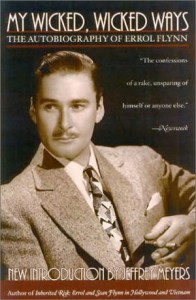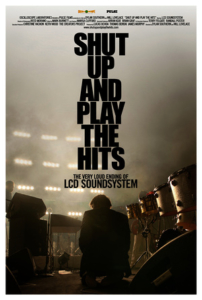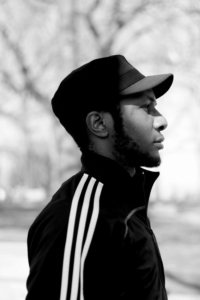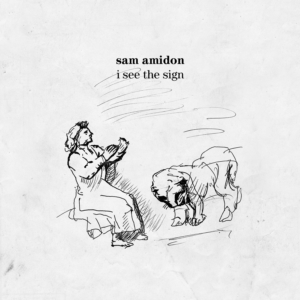 My Wicked, Wicked Ways, by Errol Flynn
My Wicked, Wicked Ways, by Errol Flynn
[Cooper Square Press; 2002]
“I was a little young perhaps to go in for slave trading, but it was an acknowledged way to turn a penny.” This is Errol Flynn looking back on his job prospects as a young man trying to make his way in New Guinea.
“I will not subscribe to the words of Rudyard Kipling ‘. . . the cold hard flesh of the heathen Chinee —‘ Let me tell you, Mr. Kipling, there is nothing hard or cold about the flesh of the heathen Chinee.” This is Errol Flynn finding the silver lining in his experience of being rolled by a woman named Ting Ling O’Connor in the opium dens of Macau.
“She knew, however, that she was the greatest — bar none, no holds barred. I record it as a fact of any possible interest to future historians. I do not know where she had learned the arts of amour, or whether she was born gifted, but I had the feeling that she performed as if she personally was convinced that she carried with her all the legend, glory and reputation of the French.” This concerns Lili Damita, the first wife of Errol Flynn, whose rapacious nature also left memorable impressions on his finances after the divorce.
“Having decided to take things slowly — bear in mind this was in the middle of the double statutory rape trial — it took me about a week to advance the hand-kissing stage up her arm. However, I was careful not to make the deadly proposition, or at least not to rush it.” This is Errol Flynn guiding his readers through the complications of dating in the public eye.
As a point of fact, Errol Flynn is a pathological liar and My Wicked, Wicked Ways is pure pulp. But that being said, it’s hard to imagine a modern celebrity attaching a sartorial air to these kinds of exploits. It takes a different kind of delusion — one that comes from a world in which beauty still guides our judgment — to write this kind of autobiography. My Wicked, Wicked Ways is kind of trashy and ridiculously fun, but one thing it is not is cheap.
— Michael Schapira, Contributing Editor
Stevie Nicks, “The Wild Heart”
This video of Stevie Nicks singing “The Wild Heart” is one of the best things I’ve ever seen on YouTube. Clipped from footage taken behind the scenes at a Rolling Stone photo shoot in 1981, the video begins with her singing “Love in Store” a cappella. She’s sitting there on a stool, getting done over by a makeup artist, practicing the song that would open Mirage two years later, when all of a sudden a Lindsey Buckingham guitar line plays over the speakers and she stops.
What happens next is pretty amazing. Visibly excited, she smiles at her makeup artist and says something like “This is the one . . .” (it’s a VHS transfer and the audio quality is low). Then she points off camera and sort of zones out in that way talented, possessed people do and starts into “The Wild Heart.” And she just kills it. I mean kills it.
There are a lot of reasons I’m recommending this video. First, it’s an incredible performance. Second, it’s just practice. We’re talking about practice, here. Stevie Nicks sits on that stool for the whole video, singing for herself, as far as I can tell, and it’s totally captivating. Sometimes it’s more than captivating, and effects that rare emotional transfer we want from great art. Seriously though, try watching her feel this song and not feel it yourself. Damn, not happening!
The third reason I recommend this video is because it’s the only place this song exists. Sometime between when this footage was shot and the release of Mirage, the backing track heard here became “Can’t Go Back,” that album’s second cut. One year after that, “The Wild Heart” would show up as the title track on Nicks’ second album, but there it’s muffled by production and pretty unlistenable. Who knows whether the version of the song in this video was ever intended to be recorded; both Nicks and Buckingham has just launched solo careers and everyone was getting protective of material. As a result, the song here is anomalous; unperformable, an artifact of collaboration and copyright law, it only exists off the record. It’s perfect then for YouTube, haven that it is for parodies and mashups and fan videos, but it’s also a credit to the site, our archive of the unofficial.
— Jesse Montgomery, Managing Editor
Shut Up and Play the Hits, dir. Dylan Southern and Will Lovelace
 James Murphy turned 40 and decided to end his band. Fair enough, especially considering that the 3 1/2 albums LCD Soundsystem put out are unequivocal in their ability to quote 30 years of electronic music while focusing our attention on the moment (the moment being irreversibly passed). As the unbearable Chuck Klosterman points out, almost all of LCD Soundsystem’s songs are about aging, looking back on a moment, trying to capture something that is already gone. And that has to do with the fact that Murphy started the project when he was already 30, about the time someone of his emotional ken might be putting together their first novel.
James Murphy turned 40 and decided to end his band. Fair enough, especially considering that the 3 1/2 albums LCD Soundsystem put out are unequivocal in their ability to quote 30 years of electronic music while focusing our attention on the moment (the moment being irreversibly passed). As the unbearable Chuck Klosterman points out, almost all of LCD Soundsystem’s songs are about aging, looking back on a moment, trying to capture something that is already gone. And that has to do with the fact that Murphy started the project when he was already 30, about the time someone of his emotional ken might be putting together their first novel.
Besides the occasional appearance by Klosterman, Shut Up and Play The Hits, which follows the 24 hours during and after LCD Soundsystem’s final performance last year, is just as it should be: a celebration and mourning of a band that was so focused on its own fragility and possible obsolescence that it made music worth listening to, and not stuff that would quickly get run over by the unforgiving spasms of popular culture.
The film begins with Murphy waking in his Williamsburg apartment, picking up the pieces after the last party for the final show. He walks his dog. He ignores some phone calls. He looks — not old, but no longer the type of person who should (or better, even wants to) run around on stage with all his friends. Still, it’s not easy to let go.
When he has to check in on the equipment before it gets sold off, he breaks down in tears. The last shot in the film is of a attendee, maybe 16, also breaking down. As Murphy explains in the film, the concert has to be about that 16 year old, the one who lets music or a scene or something that isn’t part of their shitty life, take them over and release them. If the scene is going to be ceaselessly replicated, then the pure exhilaration of recognizing there are aliens in our midst — people who make music for a living — has to be celebrated. LCD Soundsystem knew that; knew that it’s just an odd, wonderful affair to be a rock star, and they, to our benefit, let us in on that joy (and alternately, the despair of the party being over).
It’s good they ended. Imagine Murphy writing songs about the further Disney-fication of New York, the deaths of other friends, and the sad trick of time (ceaseless, man). Shut Up and Play The Hits is a wonderful document of a band whose own self-conscious brilliance will be listened to for a long time. Or not.
— Max Rivlin-Nadler, Blog Editor
Sam Amidon, “Relief”
I saw Sam Amidon in concert in the fall of 2010. Stuck in among beautifully off-kilter renditions of traditional songs, Amidon played his cover of R. Kelly’s “Relief.” He told the audience:
“When I first heard this song it was two and a half years ago and at the time it pretty much blew my mind because I realized he’d done something extraordinary which was to write a song which, at the time at least, had no bearing on reality whatsoever.”
I don’t think Amidon’s cover is ironic or a parody. I think it’s heartbreaking, actually — it’s full of resignation as much as relief. The album that includes “Relief,” I See the Sign (2010), was recorded and mixed in Iceland and includes strings, brass, woodwinds, and even Beth Orton. But Amidon’s ambling, paired-down, occasionally deadpan voice always keeps the songs on track.
Amidon comes from a prodigious family of musicians. His brother Stefan is the drummer of The Sweetback Sisters, another band I enthusiastically recommend.
— Anna-Claire Stinebring, Reviews Editor
 Double Take, by Teju Cole
Double Take, by Teju Cole
Teju Cole could write an essay about the 1040 tax form and I would probably read it. If you’re already familiar with Cole, it’s likely from his 2011 debut novel Open City, an entrancing wander through the solitude of New York, a flâneur novel for a lonely century. The novel received, justly, accolades from all corners; even the notoriously cantankerous James Wood of The New Yorker couldn’t help but praise the novel’s “acute, and sympathetic, eye.” Cole’s writings elsewhere display that same distinct vision, at once otherworldly and playful. His Twitter feed is a perfect introduction, with individual tweets that are fulfilling both when read individually and, as in his October 2011 appreciation of Swedish Nobel-winning poet Tomas Tranströmer, when compiled into longer, more traditional narrative forms.
For me, the most fascinating part of Open City may have come at the very end, when Cole’s biography noted that he had studied early Netherlandish art at Columbia University. Certainly this artistic training had informed Cole’s authorial vision, and when The New Inquiry announced Cole’s addition to their already-impressive stable of bloggers, I knew his blog would be vital reading. Double Take, his reflections on “vision, visuality, and visual culture” may be only two entries old, but they’re both keepers. The most recent post uses Jan van Eyck’s “Man in a Turban” as a pivot to challenge the perceived cosmopolitanism of an era that prohibits Muslim women from wearing similar garments. It’s erudite and gorgeously written, as readers of Open City would expect, and while the posts may be few and far between, I’ve no doubt that they’ll be well worth the wait.
— Brendan Roach, Blog Editor
This post may contain affiliate links.









